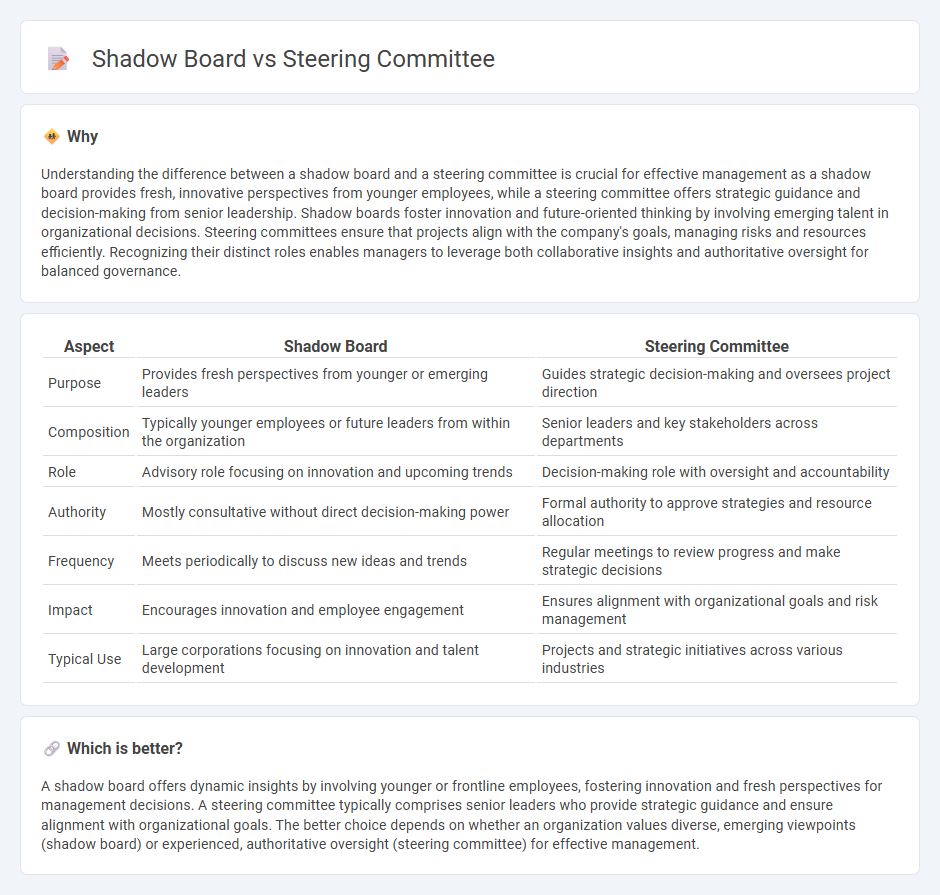
Shadow boards consist of emerging leaders who provide fresh perspectives and innovative ideas to influence strategic decisions within organizations. Steering committees are formal groups of senior executives responsible for guiding project direction, oversight, and resource allocation. Explore the differences in roles and impact between shadow boards and steering committees to enhance management effectiveness.
Why it is important
Understanding the difference between a shadow board and a steering committee is crucial for effective management as a shadow board provides fresh, innovative perspectives from younger employees, while a steering committee offers strategic guidance and decision-making from senior leadership. Shadow boards foster innovation and future-oriented thinking by involving emerging talent in organizational decisions. Steering committees ensure that projects align with the company's goals, managing risks and resources efficiently. Recognizing their distinct roles enables managers to leverage both collaborative insights and authoritative oversight for balanced governance.
Comparison Table
| Aspect | Shadow Board | Steering Committee |
|---|---|---|
| Purpose | Provides fresh perspectives from younger or emerging leaders | Guides strategic decision-making and oversees project direction |
| Composition | Typically younger employees or future leaders from within the organization | Senior leaders and key stakeholders across departments |
| Role | Advisory role focusing on innovation and upcoming trends | Decision-making role with oversight and accountability |
| Authority | Mostly consultative without direct decision-making power | Formal authority to approve strategies and resource allocation |
| Frequency | Meets periodically to discuss new ideas and trends | Regular meetings to review progress and make strategic decisions |
| Impact | Encourages innovation and employee engagement | Ensures alignment with organizational goals and risk management |
| Typical Use | Large corporations focusing on innovation and talent development | Projects and strategic initiatives across various industries |
Which is better?
A shadow board offers dynamic insights by involving younger or frontline employees, fostering innovation and fresh perspectives for management decisions. A steering committee typically comprises senior leaders who provide strategic guidance and ensure alignment with organizational goals. The better choice depends on whether an organization values diverse, emerging viewpoints (shadow board) or experienced, authoritative oversight (steering committee) for effective management.
Connection
Shadow boards consist of younger or emerging leaders who provide fresh perspectives and innovative ideas to an organization's senior management. Steering committees are formal groups overseeing strategic projects or initiatives, ensuring alignment with organizational goals. Shadow boards often advise steering committees by offering insights that influence decision-making and strategic direction within management frameworks.
Key Terms
Governance
A steering committee typically oversees project governance by providing strategic direction and ensuring alignment with organizational goals, while a shadow board functions as a governance innovation tool by simulating executive decisions and offering fresh perspectives from emerging leaders. The steering committee's role is grounded in accountability and formal oversight, contrasted with the shadow board's emphasis on challenge and development within governance structures. Explore the distinct governance functions and benefits of steering committees and shadow boards to enhance organizational decision-making.
Decision-making
A steering committee typically comprises key stakeholders who provide oversight and guide strategic decisions within an organization, ensuring alignment with corporate objectives. A shadow board consists of younger employees or diverse members serving as an advisory group to challenge senior management perspectives and inject fresh insights into decision-making. Explore the distinct roles and benefits of steering committees and shadow boards to optimize your organization's governance and innovation strategies.
Innovation
Steering committees typically consist of senior executives who provide strategic guidance and oversight for innovation initiatives, ensuring alignment with organizational goals and resource allocation. Shadow boards, composed of younger or non-executive employees, offer fresh perspectives and challenge traditional approaches, fostering a culture of creativity and disruptive innovation. Explore how integrating these governance models can accelerate innovation and drive competitive advantage.
Source and External Links
What is a Steering Committee? - This page provides an overview of steering committees, including their roles in advising, budgeting, and monitoring project quality and risks.
What's a steering committee, and should you create one? - This article discusses the role of steering committees in providing direction, setting goals, and managing budgets and timelines for projects.
Steering Committee: What It Is & How to Build an Effective One - This article outlines how steering committees work on both project and organizational levels, focusing on strategic direction and resource allocation.
 dowidth.com
dowidth.com